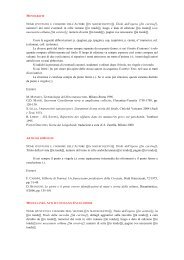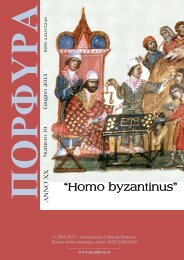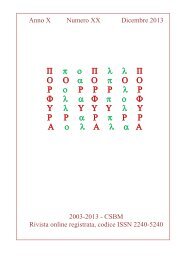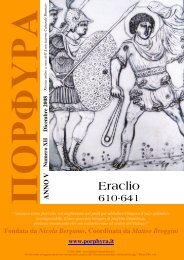ΠΟΡΦΥΡΑ - Porphyra
ΠΟΡΦΥΡΑ - Porphyra
ΠΟΡΦΥΡΑ - Porphyra
You also want an ePaper? Increase the reach of your titles
YUMPU automatically turns print PDFs into web optimized ePapers that Google loves.
A Prôtospatharios, Magistros, and Strategos Autokrator of 11 th cent.<br />
the equipment of Georgios Maniakes and his army according to the Skylitzes Matritensis miniatures<br />
and other artistic sources of the middle Byzantine period.<br />
fastened on sides by means of leather thongs (fig.15 n. 21) as<br />
those You could see in the miniature of David and Goliath of<br />
Cod. Parisinus Graecus 139 of 10 th cent 299 . This is a<br />
extraordinary source which shows us a way of fastening a<br />
leather cuirass, and the same way of fastening is shown for the<br />
scale klibanion worn by Basil I in the folio 86r of the<br />
Scylitzes. 300<br />
Smaller lamellae grew thinner narrowing on the<br />
shoulders. So in the reconstructed cuirass of our man the 16<br />
rows of scales end on the shoulders with what look like a<br />
transversal joint 301 which could reinforce the idea of two valves<br />
united and fastened, on the sides by laces, and on the shoulder,<br />
by means of clasps (fig. 15 n. 22) which may be similar to some<br />
fragments of the lamellar armour found in the Great Palace 302 .<br />
The under cuirass garment does not look as muscledshaped<br />
in the source, because the warrior, apart from helmet and<br />
armour, is armed in a more western fashion. It has got, in any<br />
case, decorative shoulder pieces remembering the ancient ones<br />
(fig. 15 n. 23).<br />
The spear carried by the men in the Capua Exultet is<br />
undoubtely of the typical “winged”one, so called for its iron<br />
projections on every side of the grove in the wood pole. This<br />
weapon, derived from Germanic races , was used or for war or<br />
for hunt, but as a war weapon it reached its finest development<br />
in the Carolingian age, as attested and used by all the Northern<br />
and Mediterranean races, including East-Romans, Franks,<br />
Vikings, Muslims and Slavs 303 .<br />
The specimen in the reconstruction has been copied from<br />
point GW959 found in the Arabo-Byzantine shipwreck of Serçe<br />
Limani 304 . Apart from its similarity, in style and proportions to<br />
Identical armour but of metallic plates is worn by a warrior in the same Exultet of Pisa, Temporal Authorities, 2, s.<br />
Exultet, p. 173.<br />
299<br />
Heath, Byzantine armies, p. 33.<br />
300<br />
The detail is very clear in Sherrard, Byzanz, p. 67, where the ending part of the laces goes out from the right side of<br />
the κλιβανιον.<br />
301<br />
Better visible at the scanner.<br />
302<br />
Talbot Rice, The Great Palace, pl. 58 fig. 7.<br />
303<br />
S. Kovacs L., Bemerkungen zur Bewertung der Frankischen Flugellanzen im Karpatenbecken, in Mitteilungen des<br />
Archäologischen Instituts der Ungarischen Akademie der Wissenschaften, 8/9 1978/1979, pp.97-119, pls. 59-68;<br />
Paulsen P., Flügellanzen zum archäeologischen Horizont der Wiener Sancta Lancea, in Frümittelalterliche Studien 3,<br />
pp. 289-312, pls. XIX-XXI; a good specimen in a Lombard-East-Roman context was found in Nocera Umbra, grave 6,<br />
together with other weapons of Eastern Mediterranean origin; s. Paroli-Arena, Museo dell’alto Medioevo, Roma 1993,<br />
pp. 32-33 fig. 29; the evidence of the use by East-Roman troops of this kind of weapon is well attested, for Italy, in the<br />
famous Crucifixion fresco of Santa Maria Antiqua, in situ, Forum Romanum, dated 700 circa, where Longinus holds<br />
this kind of spear, cfr. P. Romanelli, Santa Maria Antiqua, Roma 1999 pl. VII; a very nice specimen found in Rome<br />
and dated to the same period is now shown in the Crypta Balbi Museum. For 9 th cent. Constantinople, we can clearly<br />
distinguish it in the hands of one of the Guards of Salomon in folio 215 v of Gregorius Nazianzenus 510, representing<br />
probably an Imperial Primikerios Kandidatos, s. note 94 above. For their use by the Vikings see Nurmann, The Vikings,<br />
pp.14-15; and the Muslims Nicolle D., Armies of the Caliphates 862-1098, London 1998, p. 17 pl F.<br />
304<br />
45 cm. length. For what concerns the whole length of the spear, the wood fragments attached to the same suggest a<br />
total length of 1 m. and an half (pole and head together). It was directly put in the wood pole, without rivets. S.<br />
Schwarzer J.K., Arms from an eleventh Century Shipwreck, in Graeco-Arabica IV, 1991, pp. 327-350, p. 329, fig. 5.<br />
The armament discovered in the eleventh century shipwreck of Serce Limani, always more considered a Byzantine ship<br />
48

















